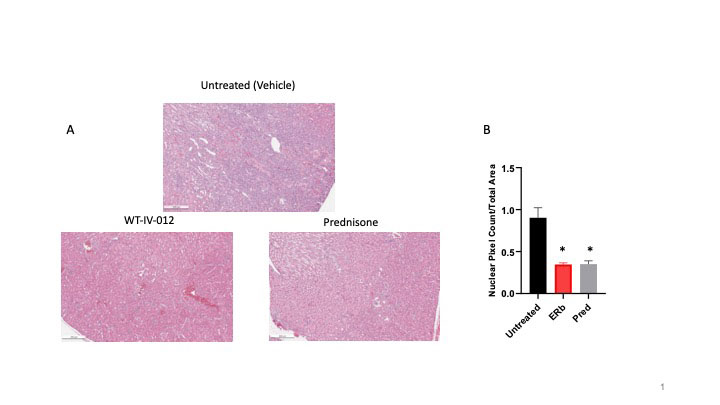Session Information
Date: Monday, November 14, 2022
Title: SLE – Animal Models Poster
Session Type: Poster Session D
Session Time: 1:00PM-3:00PM
Background/Purpose: Systemic lupus erythematosus (SLE) is an autoimmune disease characterized by multiple organ damage, mainly affecting young women between the ages of 15 and 45 years at a 9:1 rate as compared to men. The etiology of SLE is complex and remains elusive, however the susceptibility of women during the years in which estrogen levels are at their highest may suggest a significant and critical contribution to the development of SLE. Estrogens are known to have pleiotropic effects on the immune system which is mediated through either estrogen receptor α (ERα), estrogen receptor β (ERβ) or the cell surface G-protein coupled receptor GPER1. ERα has been studied extensively in this context, however ERβ and GPER1 have received much less attention. Previously, our group and others have shown that ERα carrying immune cells are mediators of proinflammatory effects of estrogen more so than cells that lack this receptor. In the pursuit of a drug that is tailored to have a favorable selective estrogenic effect, the OSU Drug Development Institute discovered a novel carborane-based selective estrogen receptor modulator (SERM), WT-IV-012. This ERβ agonist exhibits potent binding of human ERβ (Ki = 2.0 nM) and functional selectivity for ERβ over ERα of at least 200-fold. The work presented herein describes the potential utility of WT-IV-012 in treating SLE in a humanized mouse model of the disease.
Methods: PBMC isolated from patients with active SLE were adoptively transferred into NSG mice and allowed to expand in vivo for one week. The mice were divided into 3 different cohorts receiving either vehicle control, prednisone or WT-IV-012 via oral gavage on a daily basis for five weeks. Blood samples were taken at baseline, 3 and 5 weeks. Serum was analyzed for circulating cytokines using the MSD human V-PLEX Proinflammatory Panel. At 5 weeks, mice were euthanized, kidneys and hearts were harvested and processed for H&E and IHC histology. Spleen cells were cryopreserved for flow cytometry. Urine was collected and tested for proteinurea.
Results: WT-IV-012 was as effective as prednisone in suppressing immune cell invasion of the kidney as well as inflammation of the heart. Furthermore, the ERβ agonist demonstrated superior effectiveness in suppressing pro-inflammatory cytokines as compared to prednisone as well as reducing the proteinurea seen in the vehicle treated control mice.
Conclusion: We have demonstrated that WT-IV-012 is an effective inhibitor of the inflammatory process in these active SLE humanized NSG mice.
To cite this abstract in AMA style:
Bruckner S, Zeno B, Willis W, Bennett C, Jarjour W. The ERβ Agonist, WT-IV-012, Suppresses the Inflammatory Response in Systemic Lupus Erythematosus [abstract]. Arthritis Rheumatol. 2022; 74 (suppl 9). https://acrabstracts.org/abstract/the-er%ce%b2-agonist-wt-iv-012-suppresses-the-inflammatory-response-in-systemic-lupus-erythematosus/. Accessed .« Back to ACR Convergence 2022
ACR Meeting Abstracts - https://acrabstracts.org/abstract/the-er%ce%b2-agonist-wt-iv-012-suppresses-the-inflammatory-response-in-systemic-lupus-erythematosus/

